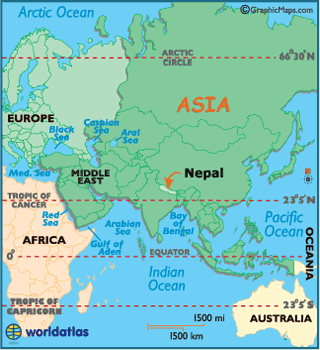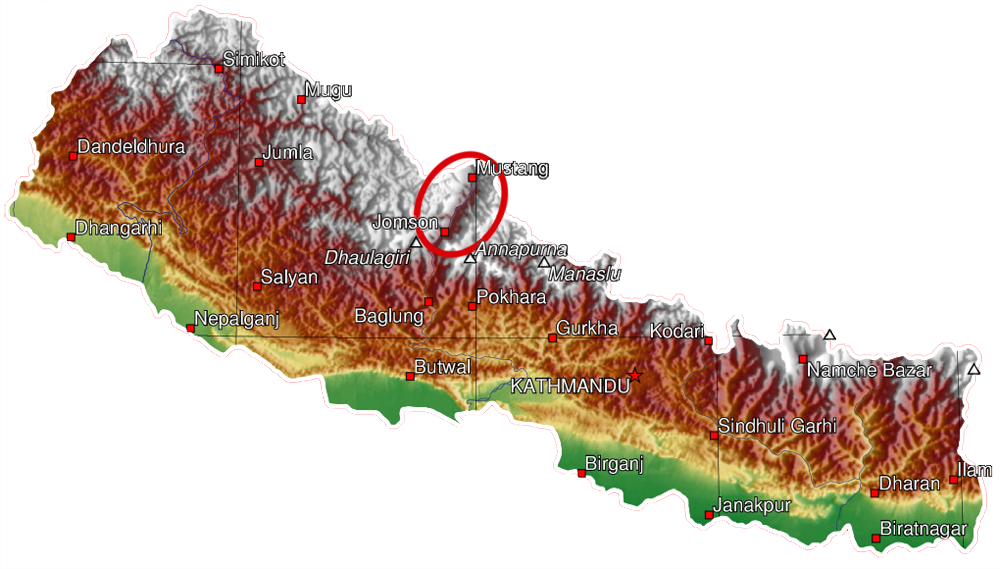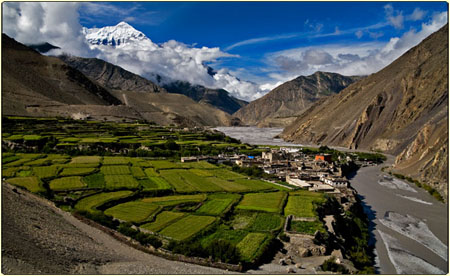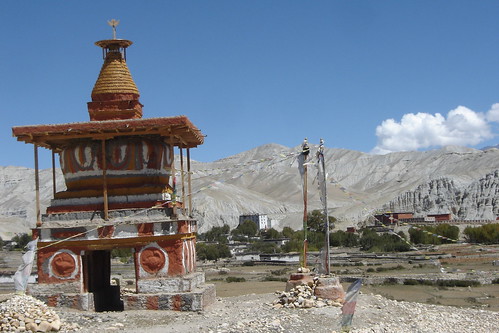“Once the travel bug bites there is no known antidote, and I know that I shall be happily infected until the end of my life” ― Michael Palin
On the other side of the world, in the country of
Nepal and in the rain shadow of the great Himalayan range, lies a land long forbidden to foreigners, a secret world untouched for centuries. It’s an ancient Buddhist
kingdom on the high Tibetan plateau. It
is known by its local name as The Land of Lo and the locals are called Lo
Bas. But a European mapmaker misspelled
the name of the capital city, Lo Monthang, and called this place Mustang (pronounced Moos-tahng). The last surviving relics of an ancient world are found here; the Buddhist monasteries of old Tibet.
This is the one of the few places in the world where
Tibetan Buddhism is practiced in its original setting. Because Mustang is in Nepal, the Chinese
didn’t come here and destroy the temples and kill the priests, as they did in
Tibet. So in Mustang you have Buddhist temples
that are six or seven hundred years old with original fresco Buddhist art. Painted at the same time as Michelangelo and
Leonardo, some of these paintings are considered masterpieces and are comparable
to the great Italian frescos of that era.
From Brown University's website on Tibetan wall paintings…
"The Mustang paintings are of inestimable value and significance; among the world's finest Buddhist wall paintings, they are rare surviving exemplars of the classical period of Tibetan Buddhist art. Following the Chinese invasion of Tibet and during the subsequent Cultural Revolution, Tibet's future was subjected to massive and brutal assault. The destruction of temples and monasteries was wholesale; from one end of Tibet's vast expanse to the other, sacred statues were smashed, murals defaced or obliterated, and entire monasteries razed, in a deliberate attempt to destroy an entire culture. Fortunately, the Tibetan cultural world and its sphere of influence extends beyond the borders of Tibet, into Bhutan and Sikkim, bordering regions of Nepal and India, and Mongolia. Although it is now part of Nepal, Mustang was formerly a small, independent Tibetan kingdom; it appears on the map as a thumb-shaped protrusion, breaking through the Himalayan wall into Tibet."
From Brown University's website on Tibetan wall paintings…
"The Mustang paintings are of inestimable value and significance; among the world's finest Buddhist wall paintings, they are rare surviving exemplars of the classical period of Tibetan Buddhist art. Following the Chinese invasion of Tibet and during the subsequent Cultural Revolution, Tibet's future was subjected to massive and brutal assault. The destruction of temples and monasteries was wholesale; from one end of Tibet's vast expanse to the other, sacred statues were smashed, murals defaced or obliterated, and entire monasteries razed, in a deliberate attempt to destroy an entire culture. Fortunately, the Tibetan cultural world and its sphere of influence extends beyond the borders of Tibet, into Bhutan and Sikkim, bordering regions of Nepal and India, and Mongolia. Although it is now part of Nepal, Mustang was formerly a small, independent Tibetan kingdom; it appears on the map as a thumb-shaped protrusion, breaking through the Himalayan wall into Tibet."
Until 1993, foreigners were not allowed into
Mustang. This had to do with the Tibetan
invasion, wars and just the fact that Nepal didn’t want foreigners there. The exception to this was our old friend,
Michel Piessel, who wrote the book about Quintana Roo that we talked about in
our Yucatan blog last fall. Piessel
spent a few months here in 1963 and wrote about it in a wonderful book,
“Mustang, The Forbidden Kingdom”. Well,
Mustang isn’t forbidden anymore, but very few tourists come here. Most trekkers in Nepal go to the Everest Base
Camp or the Annapurna Circuit. But you
have to get a special permit to go to Mustang and that, along with the fact
that it’s a high desert and not the usual Himalayan scenery, puts a lot of
trekkers off. So much the better for us!
About 5 years ago, Amy and I saw a program about
Mustang on PBS and put it down as a place we would like to go to. At the time, there was no road in Mustang and
the only way you could get through this area was to walk, ride a horse or fly a
helicopter. But now, the Chinese are
building a road that may be finished in a few years. This road will connect China, which lies just
north of Mustang, with Kathmandu. The
old ways of Mustang are sure to disappear when the road is finished, so we
figured now is the time to go.
Being in the rain shadow of the Himalaya, Mustang gets
very little rain and is a high desert.
We will be trekking between 10,000 and 14,000 feet above sea level. There is very little water…a river runs
though Mustang that consists of runoff from glaciers way up in the
mountains. We will have a couple of
guides and horses will carry our gear.
Showers and WiFi will probably be non existent. Well, if everyone smells bad it’s probably
not that big a deal, right?
Amy’s cousin, Nance, and Nance’s daughter, Trina, decided
to join us and we thought that we would have a joyous time with the four of us
on a guided 15 day trek. We arranged the
trek last fall and all was set up.
Then, as many of you know, Amy came down with a rare
neurological disorder, called Myasthenia Gravis. In the first year or two of contracting this
disease, a person can’t go anywhere where there is no modern medicine, as it is
possible that you could need a hospital at any time. So after much figuring out what the heck to
do, we decided that I would go ahead on this great journey and Amy would spend the time home with friends.
So off I go, traveling without my darling Amy for the
first time since we have known each other.
I will meet Nance and Trina in Kathmandu, as I am flying west through
China, and they are flying east through Dubai.
The journey will last about 20 days. A couple of days in Kathmandu, then on to
Pokhra and then to the starting point of the trek, Jomson. From Jomson, we will trek for five days up to
Lo Monthang, stay a day there, and then trek back to Jomson. On the way, we will be staying in small villages,
at local tea houses. We will visit
ancient temples, walk through the deepest canyon in the world, see some of the
most amazing landscape anywhere and just immerse ourselves in a totally
different and exotic place.

















